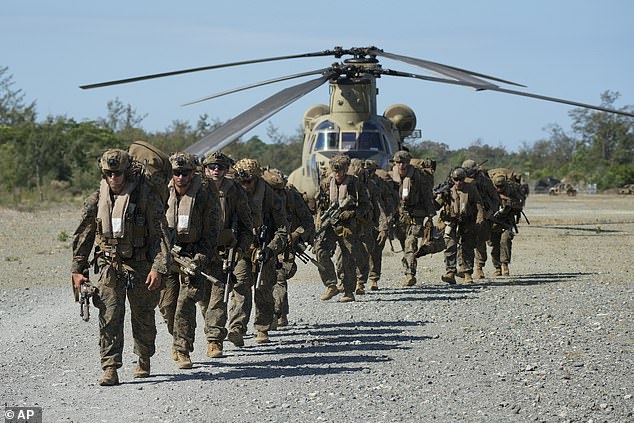The US military is actively preparing to go to war with China over growing fears of an invasion of Taiwan.
US and Philippine marines have been carrying out sinister war exercises on small islands a short distance from Taiwan, reports the Wall Street Journal.
The exercises include deploying teams of Marines from Chinook helicopters, preparing unarmed assault rifles and exploring terrain that would hypothetically be used if conflict broke out.
The developments are a disturbing glimpse into the outlook for U.S. military leaders as the hostile nation continues to threaten to invade Taiwan. Any direct conflict between the United States and China could easily lead to World War III, with both nations possessing nuclear weapons that could destroy the planet.
In anticipation of a possible Chinese invasion of Taiwan, the US military has been conducting ominous war exercises in the Philippines (pictured during a joint exercise with the Philippine military on May 6, 2024).
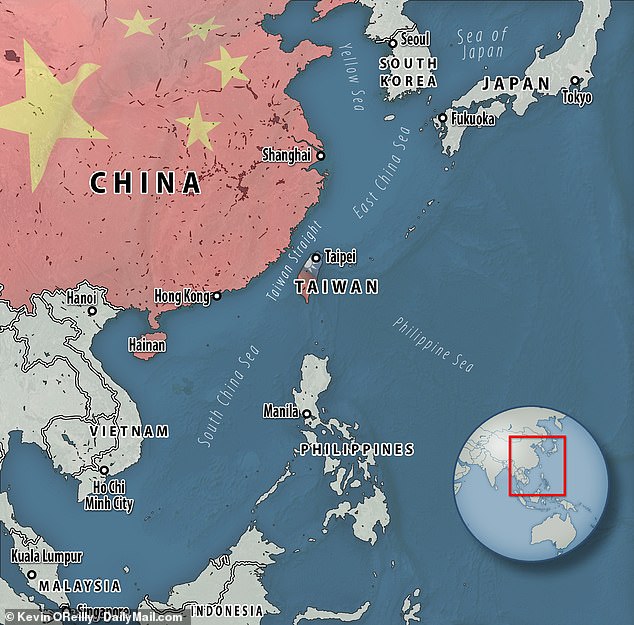
Chinese President Xi Jinping has made no secret of his desire to “reunify” Taiwan with mainland China, but has kept rivals in the dark about when he might deploy a surprise attack.
Taiwan, a successful democracy, says it does not want to be part of China. The United States has not formally said it will defend Taiwan if China invades, but President Biden has indicated that he would deploy American troops to defend the island in the event of an attack.
Recently, China has taken numerous steps that suggest it is preparing to invade, including just two days ago when the Chinese military surrounded Taiwan.
Beijing said the war games were a “strong punishment” for Taiwan following the inauguration of its new president, Lai Ching-te, and analysts saw them as another blatant display of China’s military prowess.
With this threat looming, the Wall Street Journal joined the 3rd Marine Littoral Regiment as it trained in the Philippine Islands, its fourth trip to the region.
The regiment was created just two years ago to reform the US military presence in the region and has been preparing in the Hawaiian Islands and California.
U.S. forces gained access to several Philippine military bases last year, and training exercises were held further north, on a series of islands about an hour from Taiwan.
However, the war games have supposedly reached one major and worrying conclusion: the US military needs ships to move Marines between islands in the South China Sea, which haven’t even begun construction yet.
While the training exercises did not include live bullets or missiles, the Marines were preparing for what would happen if war broke out, including abandoning the Chinook helicopters and deploying to the islands as quickly as possible.
Moving quickly and stealthily would be key to avoiding China’s sensors and drones, which Colonel John Lehane said would “complicate” the rival’s decision-making.
U.S. troops hope a series of quick, agile moves from one location to another will help strain China’s military capabilities and potentially buy time until more reinforcements arrive.
“(China) would spend an enormous amount of resources to determine where we are and what we are doing,” he said.
With stealth and agility being the Marine regiment’s priority, Lehane said the U.S. military is “continually refining the balance between what is the lightest package I can put in there to reduce the logistical burden and at the same time ensure that it’s credible in combat and capable of fighting.” .’
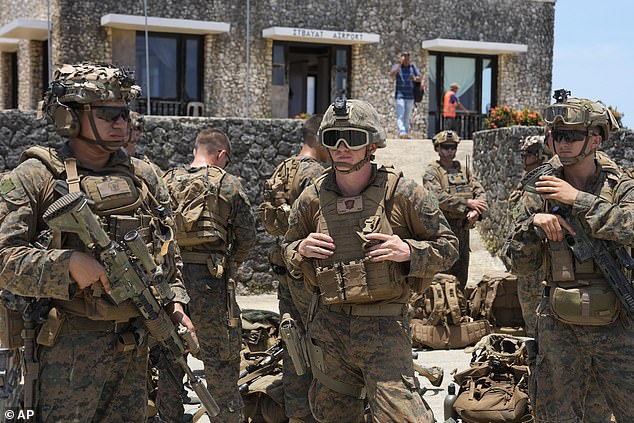
US military leaders have deployed at least four missions to the Philippines in recent months, with stealth and agility on islands scattered throughout the South China Sea being a key priority.
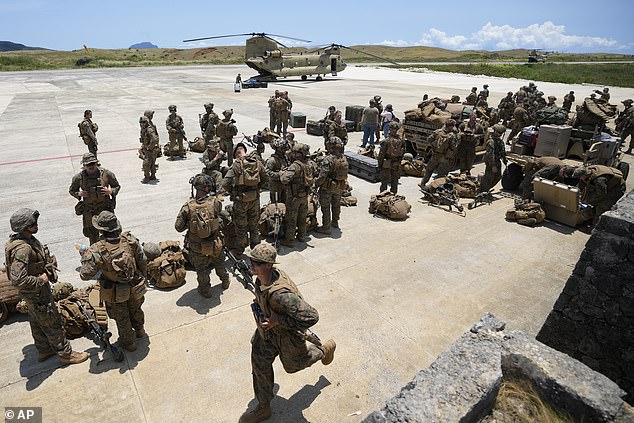
U.S. and Philippine Marines wait at the airport in Itbayat City, in the far northern Philippines, Batanes province, during a joint military exercise Monday, May 6, 2024.
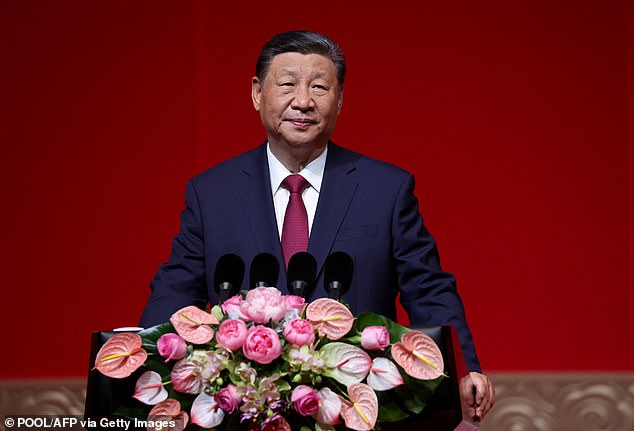
Chinese President Xi Jinping has made no secret of his desire to reunify Taiwan with mainland China, but has kept rivals in the dark about when he might deploy a surprise attack.
The outbreak of direct conflict with China would amount to a world war for many observers, even though it is understood that Beijing would have a significant advantage fighting in its own backyard.
President Biden has routinely said he would defend Taiwan if China launched an unprovoked attack, but carrying out conflict across the region’s various terrains would be much more difficult in practice.
Some islands in the South China Sea are only equipped with small heliports, roads do not connect many coastal areas that would be prone to fighting, and China would be fighting in close proximity to most of its military arsenal.
The Marines were training specifically for the early stages of the war and were reportedly tasked with stopping a possible Chinese invasion to allow other US military forces to prepare.
Using small drones and sensors, the Marines would provide a front-row view to the rest of the army and at the same time could fire on the Chinese army with a barrage of rockets.
Deploying a small covert group of Marines to the front would serve as a tactical base in the event of war, Benjamin Jensen, a senior fellow at the Washington, D.C.-based Center for Strategic and International Studies, told the WSJ.
“The ideal case is that you have these fluid forces that flow up and down the first island chain, so you are constantly forcing (China) to look for you,” he said.
“Every sensor China assigns to search a Marine Corps littoral regiment is a sensor that is not assigned to another target.”
Jensen added that the idea would be to impose a “tremendous tax” on China’s growing intelligence apparatus and that, ideally, “what you want is for them to embark on wild goose chases.”
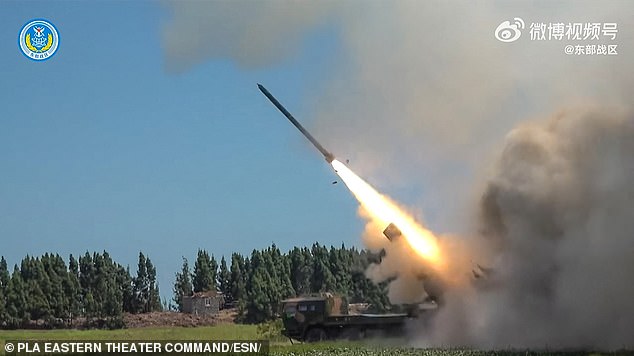
China routinely conducts war exercises in the region; Pictured here firing a missile during a training exercise in mainland China in August 2022.
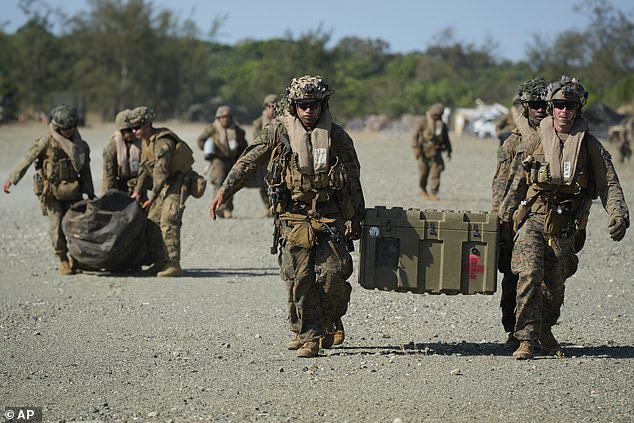
U.S. Marines transport equipment during a joint military exercise in the Philippines May 6, 2024.
Since China has a significant territorial advantage in the region, island hopping would be considered a vital technique to combat possible Chinese invasion.
During recent war exercises in the Philippines, teams flew to three small islands in the north of the country, across an area known as the Luzon Strait.
In the event of an all-out war, the islands would find themselves at the center of the conflict, and the war exercises on the islands are a sign that US military leaders may see this as a possibility.
Lt. Col. Mark Edgar, who helped oversee the training, said the exercises are primarily intended to gather data and help anticipate, and that the regiments “do assessments on the islands all the time.”
“Everything from what those runways can handle to what a harbor can handle to what a beach can handle,” he added.
The teams’ work included everything from measuring roads to how much fuel they burned, in efforts that took them to the northern tip of the islands within sight of Taiwan.
For an uncertain conflict, Edgar concluded, “Nothing takes the place of putting a Marine on the ground and really looking at that terrain.”


